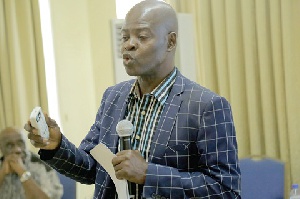General News of Wednesday, 25 July 2018
Source: classfmonline.com
Government rushing through two-track SHS system – ISODEC
The Integrated Social Development Centre (ISODEC) has accused the Akufo-Addo government of rushing through the two-track senior high school system without proper stakeholder consultation.
Government has explained that the two-track system is meant to cater for the spike in enrolment into Senior High Schools (SHSs) due to the free SHS policy.
The full implementation of the new system is expected to cost GHS323million. The objective of the double-track system is to create room to accommodate all the students, reduce class size, increase contact hours and increase the number of holidays.
The system is similar to the academic calendar used in the universities. With this system, each track will be in school for specific days for each semester and go on vacation and come back for the second semester. While the first track is in school, the second track will be on vacation and vice-versa.
In a statement, however, ISODEC said: “The speed with which government is trying to introduce the two-track SHS system i.e. two months from now, without any meaningful broad stakeholder consultations in consonance with the principles of good governance is worrying”.
“Some of us are beginning to ask ourselves whether or not the initiative’s blue print, assuming it exists, envisaged the congestion we are confronted with today, and whether or not it proposed ways of responding to it? If it did, then, was the two-track system one of the recommended responses? If so, why are we only now hearing about it?
“Because, the Free SHS blue print document has not yet been publicly disclosed, we will proceed to assume its purpose, and to suggest that, it is to address the problem of inequitable access to high school education. If this assumption is correct, then the current approach to achieving this objective may not be entirely appropriate.
“The way to address social inequity is not to accentuate it by creating equal access, even for those who can afford, but rather to introduce affirmative action policies and programmes, which create opportunities exclusively for those that ordinarily cannot afford.
“It is this principle that actuated Ghana’s first president to introduce free secondary education (feeding grant) in the northern part of the country, and NOT across the whole country.
“The suggestion has been made that assessing who qualifies for ‘free’ SHS and who does not, would be difficult. While that may be true, we should not lose sight of the fact that Free SHS could also serve as the platform for broadening the tax net, which eventually will make it easier to make such determination”.
Below is ISODEC’s full statement:
DUE DILIGENCE WOULD HAVE AVERTED FREE SHS CRISIS – ISODEC
The Integrated Social Development Centre (ISODEC) has observed with deep concern, attempts by the government to rush through a two-track Senior High School regime, as its response to the infrastructure and funding challenges confronting the implementation of its flagship Free SHS programme.
There is no doubt that the Akufo Addo-led government has good intentions for the poor, reflected in several laudable social protection programmes it has or plans to introduce. However, there is something fundamentally wrong with its approach to implementing some of these programmes.
First, the government makes very little effort to build consensus around its policies. This is evident from the inadequate public consultations it carries out ahead of its policy implementation, and which in the view of ISODEC, does not help in ensuring durability and consistency in policy implementation. Indeed such non-consultative approach to governance always comes with the risk of policy reversals by succeeding governments.
We often get the impression that, some of these policies are not properly thought through. Several of them have no proper, and publicly available policy papers backing them. Examples are: ‘Ghana beyond Aid’, ‘One Constituency-One Million Dollars’, ‘Leveraging Ghana’s Bauxite for infrastructure’ and the ‘Free SHS’ programme. It is common knowledge that, the policy papers for these and other announced programmes are still being worked on.
The speed with which government is trying to introduce the two-track SHS system i.e. two months from now, without any meaningful broad stakeholder consultations in consonance with the principles of good governance is worrying.
Some of us are beginning to ask ourselves whether or not the initiative’s blue print, assuming it exists, envisaged the congestion we are confronted with today, and whether or not it proposed ways of responding to it? If it did, then, was the two-track system one of the recommended responses? If so, why are we only now hearing about it?
The Way to Address Social Inequity
Because, the Free SHS blue print document has not yet been publicly disclosed, we will proceed to assume its purpose, and to suggest that, it is to address the problem of inequitable access to high school education. If this assumption is correct, then the current approach to achieving this objective may not be entirely appropriate.
The way to address social inequity is not to accentuate it by creating equal access, even for those who can afford, but rather to introduce affirmative action policies and programmes, which create opportunities exclusively for those that ordinarily cannot afford.
It is this principle that actuated Ghana’s first president to introduce free secondary education (feeding grant) in the northern part of the country, and NOT across the whole country.
The suggestion has been made that assessing who qualifies for ‘free’ SHS and who does not, would be difficult. While that may be true, we should not lose sight of the fact that Free SHS could also serve as the platform for broadening the tax net, which eventually will make it easier to make such determination.
Proof of tax registration could be use as parents’ qualification to access this benefit. Beyond that, it is easy to start from the formal sector. All workers over and above a stated grade or salary threshold should be excluded from the programme. For the informal sector, as already indicated, proof of tax registration should form the initial qualification, and subsequently, turnover used to assess continued eligibility.
All children coming from rural and urban poor communities and schools should automatically qualify for the programme. To encourage farming, we may even want to automatically qualify children of full-time farmers.
Source of the Classroom Congestion
At the inception of the Free SHS programme, ISODEC called for the accommodation of dissenting views. We indeed went on to call for a national dialogue on the policy. These were however disregarded. It was clear to us that, the implementation of the policy was going to create problems that will eventually come back to threaten its sustainability.
Available information on 2017 SHS enrolment suggests that, though there has been some increase in senior high school enrolment since the inception of the Free SHS, the increase has been very marginal.
The question, therefore, is, how this marginal increase has led to so serious a congestion as to warrant the introduction of a two-track system? The evidence on the ground suggest that the congestion has been brought about not by enrolment numbers, but by majority of students, including those who under normal circumstances would have opted for day stream, now opting for boarding. The pressure therefore is on boarding facilities, compelling many schools to convert some of their classrooms into sleeping places, and therefore creating congestion in the classrooms.
The two-track system may, therefore, not be the best approach to decongest the boarding facility and the classrooms. As we’ve been told, that approach will require the recruitment of 10,000 new teachers, a recurrent cost that will further compound government’s liquidity challenges.
The Way Forward
Two main options in our view, could best decongest our schools and improve the quality of teaching and learning. First, is to make parents cater for the feeding of their wards either in part or fully. This will provide the incentive for some to revert to the day stream. Such policy measure should be accompanied by continuing with the NDC’s school infrastructure projects to continually expand classroom infrastructure.
The second option, which Uganda has implemented quite successfully, is to pre-qualify some private High Schools with adequate facilities to participate in the Free SHS programme. In fact we have done same in the health sector, where some private health facilities are accredited to provide NHIS sponsored services.
The lesson we draw from the path we have travelled so far is that, perhaps, if the government had modelled the input-output-impact of its policy, consulted more, a lot of the challenges besetting the programme today would have been averted. Maybe the Free SHS wouldn’t have been introduced in the first year.
Bringing it on in the second or third year of the government’s current term would have provided the space and comfort to prepare for the challenges that confront us today.
Signed Dr Steve Manteaw Policy Analyst / Campaigns Coordinator













